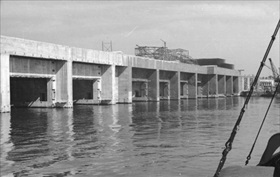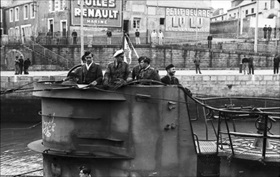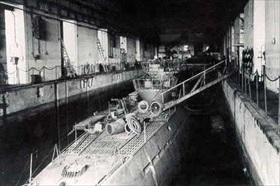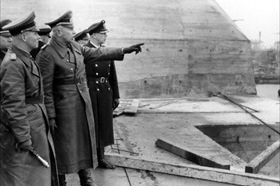EIGHTH AIR FORCE BLASTS U-BOAT PENS IN FRANCE
London, England · January 3, 1943
By the end of 1942 U-boats operating from ports in Germany and occupied Europe had sunk just over 1,160 ships (see Battle of the Atlantic). U‑boats claimed nearly 70 percent of all Allied and neutral shipping losses (about 7.8 million tons), and the Kriegsmarine appeared to be winning the tonnage race, sinking one million more tons of shipping than was built in 1942. On this date in 1943 in France, the U.S. Eighth Air Force blasted the heavily fortified U‑boat base at St. Nazaire on the Bay of Biscay, home to the Sixth and Seventh Kriegsmarine Flotillas. Built between 1941 and 1942, St. Nazaire was one of five bases on the French Atlantic coast and could accommodate the largest German U‑boats in its fourteen concrete pens. (The other U‑boat bases were at Brest, Lorient, La Rochelle, and Bordeaux.) Thirty-six-year-old Col. Curtis LeMay led 85 B‑17 Flying Fortresses and 13 B‑24 Liberators on the mission. On this sixth attack on the facility, the bombers dropped 171 tons of bombs using formation precision bombing tactics for the first time. (LeMay, commander of the 305th Bomb Group at Grafton-Underwood in Britain, identified his best bombardiers, made them “lead bombardiers” for the formation, and had all of the aircraft drop their bombs when the lead bombardier did.) As a result of this raid, the Allies implemented an incendiary bombing campaign on French-based U‑boat pens and their surrounding cities in order to cut the supply lines to the U‑boat bases. (The city of Lorient, for example, was almost completely destroyed.) When LeMay mounted attacks against targets in the German heartland later in the year, he refined his firebombing tactics to increase coverage. Indeed, over the course of the war in Europe, the bombing that damaged Germany most was not inflicted by British aviators but American, who regularly used a high percentage of incendiaries in the hope that a wider circle of destruction would take out the target. It came at a heavy price, though. For the bomber offensive as a whole, the Eighth Air Force lost 4,182 aircraft from a total of 273,841 attacking, a rate of 1.5 percent. The RAF’s Bomber Command aircraft loss rate for the same period was 2.5 percent. The 250,000 aircrew members who flew bomber missions in the Eighth Air Force sustained 58,000 casualties—18,000 killed, 6,500 wounded, and 33,500 missing.
[amazon_carousel widget_type=”ASINList” width=”600″ height=”200″ title=”Recommended Reading” market_place=”US” shuffle_products=”False” show_border=”False” asin=”1841762318,0275981339,1841765562,1904687962,1591143691,1932033432,0230613969,0451228715,0440226481,0743235452″ /]
U.S. Eighth Air Force and the U-Boat Pens at St. Nazaire
 |  |
Left: The Kriegsmarine’s St. Nazaire base in its late stages of completion, April 1942. The building of the massive U-boat pens on France’s west coast began under Adm. Karl Doenitz, then supreme commander of the U‑Boat Arm, in February 1941 with pens 6, 7, and 8, which were completed in June 1941. From July 1941 to January 1942, pens 9 through 14 were built, followed by pens 1 through 5 between February and June 1942. The base, at 984 ft (300m) long and 426 ft (130m) wide, was protected by a four-layer, 59-ft- (18m-) high roof dotted with anti-aircraft weaponry, machine guns, and mortars. (St. Nazaire had the most complete roof structure of all the Bay of Biscay bases.) The defenses of the five German U‑boat fortresses in France were so strong that Gen. Dwight D. Eisenhower, Supreme Allied Commander in Europe, ultimately decided to seek their containment rather than their destruction.
![]()
Right: On September 29, 1940, the first U-boat arrived in St. Nazaire, three months after France’s surrender. U‑203, the first boat to use the new bunker at St. Nazaire, arrived on June 30, 1941. The boat was sunk April 25, 1943, by British aircraft and a British warship. In this photo from June 15, 1942, a U‑boat is seen entering or leaving the harbor. The base was fully operational by October 1942, with both the Sixth and the Seventh U‑Boat Flotillas calling St. Nazaire home.
 |  |
Left: St. Nazaire pens 1 through 8 were dry docks, 301 ft (92m) long and 38 ft (11m) wide; pens 9 through 14 were wet pens, 223 ft (62m) long and 55 ft (17m) wide, each capable of holding two submarines. When built out, the St. Nazaire U‑boat base could accommodate 20 U‑boats. The base was equipped with 62 workshops for preparing torpedoes, repairing engines and motors, welding, etc. There were 97 stores for storage of spare parts, 150 offices, 92 individual and group dormitories for submarine and maintenance crews, 20 pumping stations, 4 kitchens, 2 bakeries, 2 electrical plants, a restaurant, and a hospital.
![]()
Right: This photo shows Field Marshal Erwin Rommel (left) inspecting the St. Nazaire base on February 18, 1944, from the roof during one of his inspections of the Atlantic Wall. To Rommel’s left are army Gen. Wilhelm Fahrmbacher (pointing) and harbor commandant Commander (Fregattenkapitän) Ernst Kellermann. The pens still stand, their extremely sturdy construction making demolition impractical. Today they are home to cafes, a bar, and on the roof an exhibition about St. Nazaire.
A Look at the U-Boat Pens at Lorient and St. Nazaire
![]()

 History buffs, there is good news! The Daily Chronicles of World War II is now available as an ebook for $4.99 on Amazon.com. Containing a year’s worth of dated entries from this website, the ebook brings the story of this tumultuous era to life in a compelling, authoritative, and succinct manner. Featuring inventive navigation aids, the ebook enables readers to instantly move forward or backward by month and date to different dated entries. Simple and elegant! Click
History buffs, there is good news! The Daily Chronicles of World War II is now available as an ebook for $4.99 on Amazon.com. Containing a year’s worth of dated entries from this website, the ebook brings the story of this tumultuous era to life in a compelling, authoritative, and succinct manner. Featuring inventive navigation aids, the ebook enables readers to instantly move forward or backward by month and date to different dated entries. Simple and elegant! Click 











